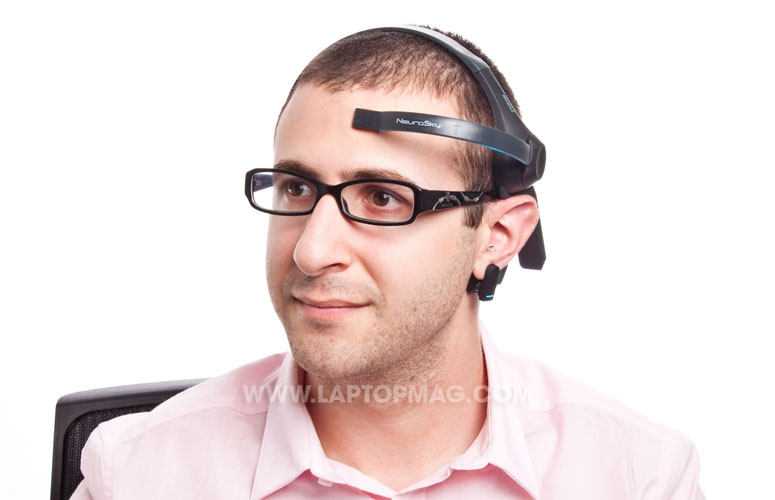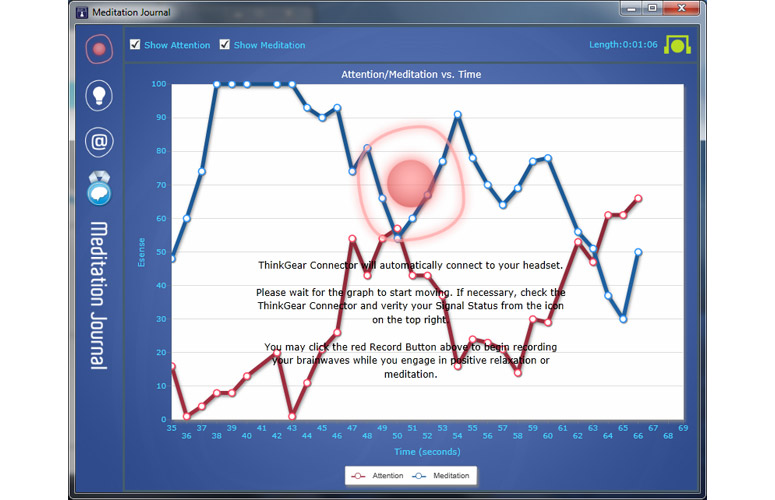Laptop Mag Verdict
NeuroSky's Mindwave Mobile innovative technology lets you control your PC or phone with your brain, but the apps aren't compelling enough.
Pros
- +
Actually responds to brainwaves
- +
Lightweight
- +
Intriguing technology
Cons
- -
Poor collection of compatible applications
- -
Difficult to control
- -
No rechargeable battery
Why you can trust Laptop Mag
Siri is so 2011. There's a new way to control your computer or mobile device that doesn't involve fingers, gestures or even your voice. For $129, NeuroSky's Mindwave Mobile reads your brain waves and uses this information to control an entire suite of applications. This mind-powered headset can perform numerous tasks when connected to compatible applications, from keeping a meditation journal built on brain waves to playing a movie. NeuroSky hopes to create a brand-new way to interact with the computer, but will this new form of input live up to the hype?
[sc:video id="FleDVqcTpVjiwmb8Niavoq6ZMi7gvDyG" width="640" height="410"]
Design

Click to EnlargeThe Mindwave Mobile looks similar to any other gaming headset, with a few important modifications. There's no speaker for the ear; instead, the Mindwave Mobile has a small clip that attaches to your earlobe. Also, there's an adjustable arm attached to a sensor that rests directly on the forehead.
This design seems a bit uninviting and we were expecting it to feel unnatural, so we were surprised at the level of comfort. While we definitely didn't forget that we were wearing the 3.2-ounce headset, there was none of the fatigue often associated with ill-fitting headphones. The ear clip was secure without being too firm and the forehead sensor rested comfortably when adjusted to the correct position.
There was still a level of relief when taking off the Mindwave Mobile, but we weren't itching to remove the device as soon as we put it on. A slight red mark on the forehead was a painless souvenir left after extended use, but that faded away in a few minutes' time.
Setup
The Mindwave Mobile is powered by a single AAA battery, surprising in a time of gadgets filed with rechargeable lithium-ion batteries. The battery isn't included with the device either, so turning on the Mindwave Mobile may require a quick trip to the store. The company says the battery should provide up to 8 hours of use.

Click to EnlargeThe first step in setting up this device is connecting it via Bluetooth to an iOS or Android device, or a computer. After the device was connected, we installed the proprietary software that gave the headset full "mind-reading" functionality. On a desktop or laptop, this meant loading the included CD-ROM and following the install prompts, and mobile devices required the Mindwave Mobile app available in the Apple App Store or through Google Play.
Regardless of device, all software initialized with a tutorial that explains how to wear and use the headset, and explained features such as attention-measuring, meditation and blink recognition.
How it Works

Click to EnlargeAfter getting the headset connected and the software installed, we wanted to jump right into the games, but found them confusing at best, unable to control the mindwave meters. We were told to concentrate, but weren't really sure what that meant.
The Brainwave Visualizer application may seem boring compared with games and movie players, but was an essential tool in learning how to use the headset. The Brainwave Visualizer displays a plethora of information about your unique brainwaves. You can watch different parts of your brain alter and move in real time, tracking Delta, Theta, Alpha, Beta and Gamma waves. There are two meters on the bottom right of the application, showing "attention" and "meditation" levels.

Click to EnlargeThe Brainwave Visualizer was extremely helpful with gaining the thought control skills required for the rest of the applications in the suite. Unfortunately, this application is not yet available for mobile devices, giving a slight handicap to users without a compatible computer.
There are two main "mind" measurements needed to control the applications included with Mindwave Mobile, "attention" and "meditation." During the tutorial, there are numerous tips for improving attention, such as focusing on a single thought, staring at a specific subject or calculating math.
We found that the most effective way to improve our attention score was to count backward from 100 in our head. The meter really did respond to our thoughts, and the measurement would show our attention steadily increasing as we continued our countdown. When we stopped, or if our mind wandered to other thoughts, our attention score immediately decreased.

Click to EnlargeThe second brainwave measurement is meditation, a score that improves as stress levels decrease. We found meditation harder to control than attention. As with the attention meter, there are tips provided in the tutorial to help improve meditation abilities, such as taking a deep breath and slowly exhaling, letting your mind wander and drift and closing your eyes. While we were able to somewhat control our meditation meter, it responded much more sporadically than the attention meter.

Click to EnlargeThe sensor on the forehead and the ear are also sensitive to movement, which we guess is how the Mindwave Mobile can detect blinks. At first, we were suspicious that movement played a main role in determining attention and concentration levels as well. However, we were not able to prove a connection between our movements and specific jumps in the meters, which convinced us that this machine could actually read our brain activity.
Applications

Click to EnlargeThe Mindwave mobile includes a suite of applications and games for PCs, in addition to the applications, both free and paid, available in the Apple and Android app stores. We were most excited about the application MyndPlayer, which allows viewers to control the outcome of a video with their minds. MyndPlayer comes with four different videos, each of which can be controlled using thoughts picked up by the Mindwave Mobile. We watched "Parkour Heros," a short film about the lively sport of parkour, and tried our hands at some mind-controlled action.
At certain parts of the film, a meter showed up at the bottom of the screen, along with the word "attention" or "meditation." When that meter appeared, we had 10 seconds to keep the levels strong, keeping the parkour-pursuit story playing, or else the hero would miss a step, fall to the ground and the cellphone-stealing villain would make his escape.
As interesting as we found the concept of mind-controlled movies, we weren't impressed by the execution. The video playback controls were very confusing: a button with an "eject" icon was actually used for selecting a film to watch and the "next" and "previous" buttons didn't navigate the film as expected, sometimes skipping scenes or returning to the beginning or end of the film. Video was also choppy between cutscenes, jerking us out of the action every time we were prompted to either concentrate or meditate. If we were unable to either focus or meditate when prompted, the movie simply ended without the option to try again.
Games

Click to EnlargeAlso included on the CD-ROM is an app called Meditation Journal and the games ZombiePOP and Man.Up. We found Meditation Journal to be one of the most useful and well- executed applications bundled with Mindwave Mobile. It allowed us to keep track of daily meditation sessions in a calendar, each of which could be measured and quantified. Real-time charts show attention and meditation levels, which give immediate feedback as the quality of meditation. Tracking each meditation in a calendar, and viewing information from multiple sessions, gave us unique insights into the quality of our meditations.
In ZombiePOP, players must use a combination of attention and blinking to blow up zombie heads and collect the medicine inside. Except for the innovative mind-reading that controls the game mechanics, the look and feel of this application feels years behind the times. Graphics were low quality, the game is repetitive and there's none of the excitement we've come to expect from modern video games. The biggest challenge was trying to only blink when required by the game; our eyes dried out and sometimes we couldn't help the unintended blinks. A head-exploding zombie game sounds exciting, but just wasn't quite up to par.
Man.Up is a game similar to the iOS and Android app Doodle Jump. Players control a jumping man with the arrow keys on the keyboard and use the headset to vary jump height and platform length depending on attention and meditation levels. This was a fun game, but just wasn't enough to really impress us.
MindGames has released two games, "W.I.L.D." and "28 Spoons Later," which use the power of concentration to control the action. In "28 Spoons Later," a zombie wants to eat your brains and you must use your mind to bend the spoons before the zombie takes a bite. In "W.I.L.D.," attention and meditation are used to complete different tasks, such as putting out a fire or bouncing a puzzle piece on a trampoline.
Due to the restrictions of the Mindwave Mobile, all games end up feeling the same. Most of the action relies on boolean queries: if the user's attention bar is full perform action A, if not, perform action B. You can either bend the spoon, or not bend the spoon. There's no other outcomes to explore.
By comparison, the now-discontinued OCZ Neural Impulse Actuator also used brainwaves to control games, but offered far greater controls, such as aiming and player movement, and worked with a number of mainstream titles, such as "Far Cry 2," "Crysis," and "Unreal Tournament 3."
Third-party developers can connect to the Mindwave Mobile to integrate brainwave readings into their own applications. Currently, there are 75 titles in NeuroSky's stores, which range from the free "Adventures of NeuroBoy" to the $500 "Research Tools," which records EEG data in real time.
Verdict

Click to EnlargeThe technology behind Neurosky's Mindwave Mobile is impressive, but is obviously still in its infancy. Included applications, such as the MyndPlayer, Meditation Journal, ZombiePOP and Man.Up show the device's cabilities, but don't penetrate much deeper than simple novelty. There is no typing with the mind or moving the mouse based on thoughts; there are only two meters, attention and meditation, and blink recognition. If third-party developers find a useful way to harness these measurements, there could be an influx of quality applications, but as it stands, the application ecosystem surrounding the device isn't nearly as robust as we'd like. The Mindwave Mobile is an interesting piece of technology, but overall, this $130 device is a bit of a head-scratcher.
NeuroSky Mindwave Mobile Specs
| Accessories Type | Toys |
| Brand | OCZ |
| Company Website | www.neurosky.com |
| Size | 8.9 x 6.1 x 6.5 inches |
| Weight | 3.2 ounces |
